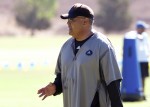Kennedy Polamalu, one offseason into being UCLA football’s offensive coordinator, has already impressed head coach Jim Mora.
“I love the schemes that we’re utilizing offensively,” Mora said Monday. “I think that Kennedy is doing an amazing job just being organized, being detailed, being demanding.”
The list of influences for Polamalu’s offensive approach runs long.
Polamalu, getting the first chance of his career calling plays this year for UCLA, rattled off names from Norv Turner to Mike Shula to Dirk Koetter when talking about the minds that have shaped his own offensive philosophy.
The most important name, though, might very well be Josh Rosen.
UCLA’s new pro-style offense was designed largely to help facilitate the star sophomore quarterback’s growth as a signal caller, Polamalu said.
“I think it’s very important for the development of a young man like himself – that he has to see the big picture, not just ‘hey, half the field is open,’” Polamalu said. “The next level, you’ve got to be able to call plays, and change the plays, change the direction, change those things.”
Polamalu’s new offense is far more extensive than that of previous coordinator Noel Mazzone, partly because it involves a variety of concepts that can be combined to create a single play.
So far, Rosen has shown the aptitude to handle it.
“He’s a bright young man,” Polamalu said. “He knows how to get us out of – if he sees pressure – to put us in the proper play. We don’t want to run a play that we can’t block up. He’s pretty bright in understanding that.”
Rosen is facing off against one of college football’s best defensive lines during fall camp, forcing him to develop his ability to move in the pocket. The test may be even stouter in the Bruins’ opener when they match up against Myles Garrett and the vaunted Texas A&M line.
In order to keep opposing pass rushers honest, Polamalu said, the UCLA running game will be vital.
“You have to be able to run the football to help (Rosen) because we just can’t drop back and just let people run at him,” Polamalu said. “So hopefully we slow them down a little bit.”
The competition at the running back position, held down by the elusive Paul Perkins last year, is wide open at this point, Polamalu said, with five powerful backs competing for time: junior Nate Starks, sophomores Soso Jamabo and Bolu Olorunfunmi and freshmen Brandon Stephens and Jalen Starks.
Ultimately, the coordinator plans to feature one man as the primary rusher while still finding opportunities for all of them.
“I would like to have one, (but) the others know that they will play,” Polamalu said. “I know the ball is not heavy, but it’s a lot of responsibility, and you’ve got to have the stamina to carry it.”
Jamabo, a former five-star recruit out of Texas, is the most highly touted of the group, but Polamalu said none of the runners has yet separated himself from the pack.
In both the running and the passing game, UCLA will lean heavily on the tight end position, which was nonexistent in the offense of previous years, to keep opposing defenses off balance.
Redshirt senior Nate Iese, who has spent time at defensive end and at the F-back position during his time at UCLA, will start in the tight end role. If the 6-foot-3, 242-pounder can hold his own against defensive linemen and linebackers as a blocker, he should find himself in advantageous matchups as a receiver.
“It’s a very big part of our offense,” Polamalu said. “If we can keep their linebackers on the field with him, you know, I think we’ve got a pretty good athletic kid there.”
Iese has displayed impressive hands throughout fall camp, and his blocking ability is coming along, he said.
“I’m doing really well blocking right now – I feel its more me learning the scheme,” Iese said. “Zone blocking, things like that, I still have to work on. Hand placement – that’s something I have to get used to. We work on that every day.”
The addition of a tight end and a fullback to the offense this year is also giving the defense a chance to practice against a bulkier opponent, which should help once the season starts, Rosen said Monday.
“Our defense, when they see a lot of different run looks, and we’re not running inside zone every play, our defensive front gets used to seeing more than just a head-on double team,” Rosen said. “They’ll get hit from the side, they’ll get pullers, they’ll get everything. It helps the defensive front. And our safeties get to play against bigger bodies, so it will help us against teams like the Stanfords.”
